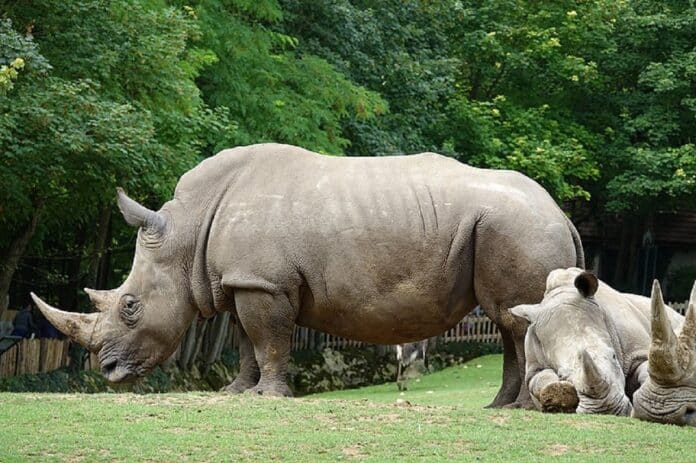Southern white rhinoceros (Ceratotherium simum simum) managed populations serve as assurance populations for similar wild species threatened by poaching and other anthropocentric consequences, while many managed populations suffer from subfertility and reproductive failure.
The gut microbiome and host health are closely connected, and food and gut microbial diversity may influence reproductive outcomes in captured southern white rhinoceros.
North Carolina State University researchers discovered substantial variations in the gut microbiota of female southern white rhinos reproducing effectively in captivity vs. females that have not reproduced successfully.
This raises concerns about the involvement of a specific genus of gut microorganisms in reducing the captive breeding of this rhinoceros species.
Christina Burnham, the first author of a paper on the work and a graduate student at NC State, said, “Our work focuses on the southern white rhinoceros (Ceratotherium simum simum) because while it is not yet endangered, species numbers are declining in the wild due to poaching.”
He also said, “There is a significant population of southern white rhinos under human care in the United States, but there have been challenges in getting many of these animals to reproduce successfully. It is critical that we understand why, as the managed rhinos serve as important assurance populations in case wild rhino numbers continue to fall. We wanted to know how the gut microbiome may influence the reproductive ability of these rhinos.”
Over six months, the researchers gathered several fecal samples from eight female southern white rhinoceroses.
The study population included two juveniles, two “subadults” who are no longer nursing but are not yet of reproductive age, two adults who have successfully reproduced, and two who have not reproduced.
He said, “We wanted to have a robust sample size that would allow us to assess the gut microbiome of females in this species while accounting for age, the time of year, and reproductive status.”
The DNA collected and analyzed from the fecal samples allowed the researchers to identify the diversity and number of bacteria in the study animals’ guts.
Erin McKenney, co-author of the study and an assistant professor of applied ecology at NC State, said, “We found differences between rhinos in each age group. In other words, microbial communities in the gut microbiome change predictably as animals age from juveniles to subadults to adults. This likely reflects, among other things, changes in the diet and behavior of the animals. This sort of microbiome ‘succession’ is fairly common in many animal species. And it’s important here because it casts the differences we found between reproductively successful adults and reproductively unsuccessful females in stark relief.”
The researcher believes that changes in the animals’ nutrition and behavior mirror changes in the gut microbiome succession as they progress from juveniles to subadults to adults.
The researchers discovered that reproductively successful females had less diversity in the types of microbial species present in their gut microbiome than reproductively unsuccessful females. They also found that each group of adults was developing microbial species previously linked to reproductive health.
Rikenellaceae, one of the microbial families discovered at multiple levels in reproductively successful adults, is thought to aid in breaking down dietary plant components in southern white rhinos.
Mobiluncus bacteria were only found to be significantly enriched in reproductively failed individuals. Previous research has linked Mobiluncus to many reproductive health issues in various non-rhinoceros animals.
However, earlier studies discovered Mobiluncus in the vaginal and cervical microbiomes. Only the gut microbiota was examined. They believe that the stomach serves as a reservoir for Mobilincus. However, they must get cervical or vaginal swabs from the adult females being tested to confirm this.
McKenney said, “Because this was a longitudinal study, we collected multiple samples from each animal over the course of half a year, And the differences we saw in the gut microbiomes of adult females were consistent over time, which suggests that these differences in microbial communities may be playing an important role in the reproductive health of these animals. That said, we must do additional research to determine what that role may be, if any.”
The study results show that our understanding of age and season-related microbial variation in southern white rhinoceros at the North Carolina Zoo has found a possible microbial biomarker for reproductive risk in managed female southern white rhinoceros.
Journal Reference:
- Burnham, C.M., McKenney, et al. Effects of age, seasonality, and reproductive status on the gut microbiome of Southern White Rhinoceros (Ceratotherium simum simum) at the North Carolina Zoo. Animal Microbiome. DOI: 10.1186/s42523-023-00249-5
